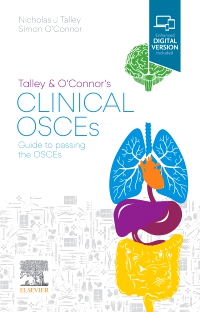
Talley and O'Connor's Clinical OSCEs, 1st Edition
Paperback

-
- 102 stations graded as Early – Mid, Intermediate and Final clinical years
- Marking criteria boxes and examiners’ likely questions to help you prepare
- Tips and hints on presenting your findings to the examiners
- Detailed method explanation to aid understanding
- Colour clinical photos and graphics to support deep learning
- An eBook included in all print purchases
-
Chapter 1. An introduction to short cases and Observed Structured Clinical Examinations – OSCEs
Frequently asked questionsChapter 2. Early to mid-clinical years
Station 1. History - chest pain and dyspnoea
Station 2. Take a history – abdominal pain
Station 3. Take a history – headache
Station 4. Wash hands and scrub for theatre
Station 5. Take the pulse and blood pressure (add pulses)
Station 6. Examine the fingernails
Station 7. Examine a lump
Station 8. Examine a body system (cardiovascular) (case 16 – expand)
Station 9. Examine a body system (respiratory)
Station 10. Examine a body system (abdomen)
Station 11. Examine a body system (upper cranial nerves)
Station 12. Examine a body system (lower cranial nerves)
Station 13. Examine a body system (arms neurologically)
Station 14 Examine a body system (legs neurologically)
Station 15. Examine the neck (thyroid)
Present your findings
Examiners’ likely questions
Station 16. Examine the neck lymph nodes
Station 17. Basic cardiac life supportChapter 3. Intermediate clinical years
Station 18. Cardiovascular risk factors history
Station 19. Obesity history
Station 20. Obesity examination
Station 21. Cardiac disease examination
Station 22. Examine a patient with hypertension
Station 23. Assess a patient with recent myocardial infarction
Station 24. Peripheral oedema
Station 25. Perform an Electrocardiogram ECG
Station 26. Assess a chronic cough
Station 27. History in a patient with breathlessness
Station 28. Examination of a patient with breathlessness
Station 29. Examine a patient with haemoptysis
Station 30. Take an occupational lung history
Station 31. Advise on smoking cessation
Station 32. Examination of jaundice
Station 33. Liver failure
Station 34. Alcohol cessation
Station 35. Abdominal pain, diarrhoea and bloating
Station 36. Perform a rectal examination
Station 37. Take a history of inflammatory bowel disease
Station 38. Inguinal or femoral hernia
Station 39. Polycystic kidneys
Station 40. Lymphoma
Station 41. Rheumatoid arthritis chronic disease history
Station 42. Examine the hands
Station 43. Examine the knees
Station 44. Examine the feet
Station 45. Examine the back
Station 46. Take a history from a patient with osteoarthritis
Station 47. Examine a patient diagnosed as having osteoarthritis
Station 48. Hypothyroidism
Station 49. Systemic lupus erythematous history
Station 50. SLE examination
Station 51. Take a history from a patient with diabetes
Station 52. Examine a patient with type I diabetes
Station 53. Take a history for suspected osteoporosis
Station 54. Acromegaly history
Station 55. Acromegaly examination
Station 56. Weight gain (suspected Cushing’s syndrome)
Station 57. Sudden visual loss
Station 58. Sclera and conjunctiva
Station 59. Sore throat
Station 60. Earache
Station 61. History from an older patient
Station 62. Examination of an older patient
Station 63. A history of falls
Station 64. Examination of a patient with a history of falls
Station 65. Mental state examination
Station 66. Depression
Station 67. Pigmented skin lesion
Station 68. Elbow rash
Station 69. Rash on the trunk
Station 70. Pruritic rash
Station 71. Examine for skin disease
Station 72. Examining a tremor
Station 73. Suspected sexually transmitted disease
Station 74. Breast examination
Station 75. Urinalysis testing
Station 76. Peak flow and Spirometry
Station 77. Cannulation
Station 78. Male catheter insertionChapter 4: Final year
Station 79. Stoma assessment
Station 80 Handover of a patient
Station 81. The angry patient
Station 82. Breaking bad news
Station 83. Cross-cultural communication
Station 84. Consenting for a procedure – blood transfusion
Station 85. Interpreting an ECG
Station 86. Interpreting a chest X ray
Station 87. Arterial blood gas interpretation
Station 88. The septic patient: a rapid assessment
Station 89. Explaining a disease – asthma
Station 90. Advanced cardiac life support
Station 91. Atrial fibrillation and anticoagulation
Station 92. Heart transplant
Station 93. Low back pain
Station 94. Multiple sclerosis
Station 95. HIV History Taking
Station 96. Pre-operative assessment history
Station 97. Pre-operative assessment examination
Station 98. Opioid prescription
Station 99. A colleague is reported to be drinking excessively
Station 100. Completing a do not resuscitate order
Station 101. Confirmation of death
Station 102. Explaining a disease – type II diabetes

 as described in our
as described in our 